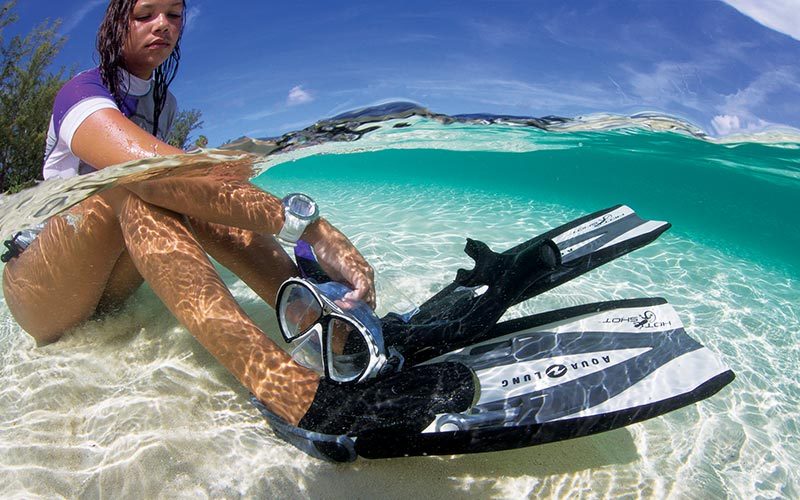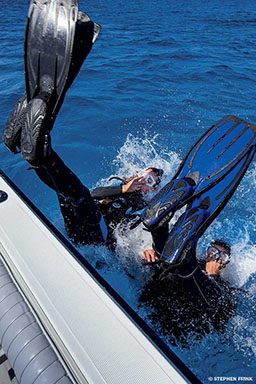As altitude increases, atmospheric air pressure decreases. This simple fact has important implications for both our bodies and the operation of depth gauges.
Rather than measuring depth directly, digital depth gauges measure absolute pressure, which includes both the water pressure and the atmospheric air pressure above the water (hereafter referred to as surface pressure). A computer cannot measure the surface pressure during a dive, so this information is determined and saved before the dive. The computer calculates depth by subtracting the saved surface pressure from the measured absolute pressure.

Errors in determining surface pressure may result from the unit being slightly submerged at the time of sampling or from defaulting to a standard value equivalent to sea-level pressure when the diver is actually at altitude. Using a surface pressure that is higher than reality is bad in two ways. First, too much pressure will be subtracted from the absolute reading, resulting in a depth estimate that is too shallow, possibly causing you to exceed your planned depth. Second, an erroneously high surface pressure estimate means the decompression calculations will underestimate the magnitude of the decompression stress, effectively increasing the risk of decompression sickness (DCS).
Weather can cause the surface pressure to vary, but only by amounts that are relatively insignificant for diving purposes (typically no more than 6 inches of water depth). Altitude, conversely, has a much larger impact. For example, diving in Lake Tahoe (elevation 6,225 feet) involves a reduction in surface pressure equivalent to about 6.5 feet of water depth compared with sea level.
When a diver surfaces at high altitude, the surface pressure is less than that of sea level. This means the diver’s tissues have a relatively higher level of supersaturation, which promotes greater bubble growth, thus increasing the risk of DCS. Decompression models used by dive computers must know either the altitude or the surface pressure so they can establish appropriate no-decompression limits. Some models do this automatically, while others require manual user input.
In a review of dive computers currently on the market, all were found to feature automatic compensation of depth readings for altitude. This is good, as it saves the user from needing to manually perform an adjustment. However, the method used to determine surface pressure varies among manufacturers, and some methods may be more accurate than others.

The ideal method for determining surface pressure would be reliable and accurate, require no intervention from the user and never be fooled by events that cause pressure changes (such as air travel or brief submergence before a dive). This can be difficult to achieve in real life, as designers must balance competing variables such as unexpected user behavior, hardware limitations and the need for low power consumption.
The computer often uses the moment of activation to sample the surface pressure. This works well when the user turns on the computer at the surface immediately before a dive. Since this step can be forgotten, however, most computers are designed with automatic activation backup. If activated while submerged, the much higher density of water compared with air can result in significant error in the surface pressure estimate for even minor depths of submergence. Auto-activation techniques must take steps to protect against such errors. Some models have wet contacts to detect the presence of water for auto-activation. Once the unit senses water, it will turn on if needed and then sample the ambient pressure. This can provide a good estimate of surface pressure, provided that the sampling is frequent and minimal descent has occurred. Wet contacts are typically sampled every 1 to 5 seconds. Problematically, significant error could result if a diver initiated an immediate descent upon entering the water.
Models without wet contacts will auto-activate when an increase in pressure is detected (i.e., a descent begins). Because these models are already underwater when activation occurs, they must keep a history of pressure samples while in standby mode and then apply an algorithm to determine the surface pressure. These methods may be complex and are not typically released in detail. Some computers detect a relative increase in pressure for auto-activation. The advantage of using a relative pressure increase is the activation depth can be the same when diving at high altitude as when at sea level. However, it is possible for sudden pressure changes to trick the computer into falsely initiating a dive.

Some computers do not auto-activate until an absolute pressure threshold is reached. While this method prevents erroneous activation, the disadvantage is that if the depth for auto-activation is 3.3 feet at sea level, it would increase to about 10 feet at an altitude of 6,500 feet. For example, some computers keep a 10-minute history of pressures and upon activation choose the lowest pressure as the surface pressure. However, a dive could conceivably begin with a long swim shallower than 10 feet, which could result in an incorrect surface pressure determination.
The simple solution to all of these problems is to manually turn on the dive computer while on the surface before the dive.
Many decompression models adjust for altitude, which makes proper surface pressure determination critical. Other computers require manual adjustments for diving safely at altitude. Divers should refer to their dive computer’s operating instructions to see if automatic altitude adjustments for depth measurements are performed and if any limitations are listed. Note that some models, especially older ones, may not provide any compensation for altitude and/or may not have an auto-activation feature.
Recommendations
As a rule, turn on your dive computer manually at the surface immediately before each dive. This will allow you to confirm normal function and adequate battery life and allow the computer to sample the true surface pressure. When at altitude, some computers will display a mountain icon or other indication that the computer has adjusted for the reduced surface pressure.
Read your computer’s operating instructions to learn its functions and limitations, and consider diving with multiple instruments — at least with a backup depth gauge. A second depth reading provides a reference to help spot errors. Ideally, the two instruments would be made by different manufacturers to avoid common failures in design or usage. Since an error in surface pressure measurement will appear as a constant offset in the depth reading throughout the dive, it can be spotted early, while the diver is still shallow.
Diving at altitude is more complex than diving at sea level, and extra steps may be required. Don’t hesitate to ask questions of your dive computer’s manufacturer if you cannot find all the information you need.
© Alert Diver — Q4 Fall 2015